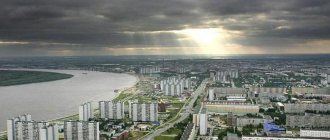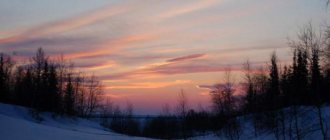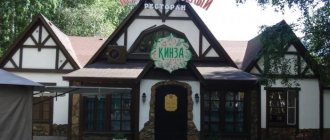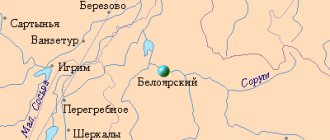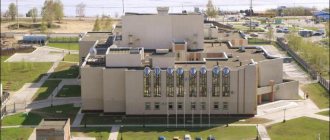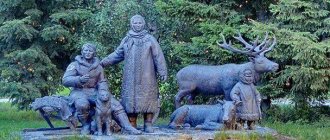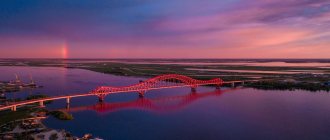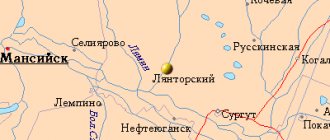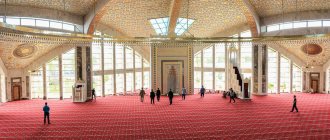Material from Documentation.
Jump to: navigation, search
Population of the Khanty-Mansiysk Autonomous Okrug
as of January 1, 2013 it was 1.58 million people. The share of the region's population in the Russian population is 1.1%.[1]
The population density of the Khanty-Mansiysk Autonomous Okrug was 2.96 people per km2 (35.3% of the same figure in Russia).[2]
In Ugra, the population mainly lives in urban areas - 1406.1 thousand people or 91.5% of the total population, in rural areas - 130.7 thousand people or 8.5%. The population density of the district is 2.9 people per 1 sq. km.[3]
The most populous cities are Surgut (308.5 thousand people or 20% of the total population of the district), Nizhnevartovsk (252.6 thousand people or 16.4% of the total population of the district), Nefteyugansk (123, 7 thousand people or 8% of the total population of the district). The administrative center of Khanty-Mansiysk ranks 5th among the cities of the district in terms of population - 79.8 thousand people, which is 5.2% of the total population of the district.[4]
Khanty-Mansi Autonomous Okrug - Ugra is the historical homeland of the indigenous population, which is represented by three small nationalities: Khanty, Mansi, Nenets. Indigenous peoples today make up about 2% of the total population of the district (30 thousand people). National composition of the population: 66.1% - Russians, 8.6% - Ukrainians, 7.5% - Tatars, 1.2% - Khanty, 0.7% - Mansi, 0.1 - Nenets, 15.8% - other nationalities.[5]
Ugra ranks 3rd among the constituent entities of the Russian Federation in terms of natural population growth. The migration increase in the district's population in 2010 amounted to 3.7 thousand people.[6]
The share of the population of working age is 69.6%, younger than working age - 19.9%, older than working age - 10.5%.[7]
KHMAO
The Khanty-Mansiysk Autonomous Okrug is truly the richest region of our country, but only after Moscow. The region is not experiencing an economic recession even now. The entire working-age population has high incomes, and local authorities are doing everything to ensure a high level of social protection for the disabled population. As a result, the number of residents is growing steadily. This happens due to natural growth and migrants.
The district administration supports residents, higher education is available to everyone, and there are many housing programs. The region is popularly called Russian Kuwait.
The residential density in the district is very low, on average there is 1 square meter per 2.7 inhabitants. km. The bulk of the population lives in cities concentrated around oil production and oil refining enterprises.
[edit] Indigenous peoples
The indigenous small peoples of the Khanty-Mansi Autonomous Okrug, the Khanty and Mansi, are two related peoples. The ethnonyms “Khanty” and “Mansi” are derived from the self-name of the Khante, Kantakh and Mansi peoples. They were adopted as official names after 1917, and in the old scientific literature and in documents of the tsarist administration the Khanty were called Ostyaks, and the Mansi were called Voguls or Vogulichs.[8]
G.S. Dunin-Gorkavich, a researcher from the beginning of the century who visited these parts, describes the Khanty as follows: “The Ostyaks as a whole are distinguished by their good nature, willingness to help everyone and strict honesty. They do not harbor any enmity towards each other and live peacefully. Begging is unknown to the Ostyaks: every poor person considers himself to have the right to come to a wealthier person and enjoy food from him, especially after a good catch of an animal or fish. Among them there is even a kind of public charity, due to which every elderly and unable to work Ostyak, if he has no relatives, is fed in turn by his relatives.[9]
Murders among the Ostyaks, due to their peace-loving nature, can be said with confidence, do not occur at all. The Ostyaks were accustomed to respecting other people's property; therefore, theft and deception among them are extremely rare.”[10]
I. G. Ostroumov (1904) gives the Voguls the following characteristics: “By their nature, the Voguls are a peace-loving, kind-hearted and good-natured people; Their mutual relations are extremely good: they do not know what, for example, deception, theft, and especially murder are.”[11]
To designate the Khanty and Mansi as a single whole, another term has been established in the scientific literature - Ob Ugrians. Its first part indicates the main place of residence, and the second comes from the word “Ugra”, “Yugoria”. This is what it was called in Russian chronicles of the 11th-15th centuries. territory in the polar Urals and Western Siberia, as well as its inhabitants.[12]
Linguists classify the Khanty and Mansi languages as Ugric (Ugric); this group also includes the related language Hungarian. The Ugric languages are part of the Finno-Ugric group of the Uralic language family.[13]
Based on the fact that the Khanty and Mansi languages belong to the Finno-Ugric group, it is assumed that there once existed a community of people who spoke this proto-language. The question of where the ancestral home of this community was located is extremely complex. Despite the ambiguity and inconsistency of the origins of the Khanty and Mansi, researchers are unanimous in their opinion that their culture is two-component, incorporating the traditions of the local taiga tribes and the Ugrians who came from the south. Linguists suggest the possibility of ancient connections of the Uralic language family with the Indo-European and Turkic, there are parallels with the Yukaghir, Chukchi-Kamchatka, Eskimo-Aleut languages, connections with the Proto-Iranian languages have been discovered.[14]
There is a point of view according to which the ancestors of the Samoyeds and Ugrians developed the territory of Western Siberia from the Mesolithic (6 thousand BC), and in the Neolithic era (4 thousand BC) the proto-Samoyeds and proto-Ugrians emerged. This chronology is relative, since in modern science there are disputes regarding the identification of archaeological cultures with specific ethnic groups. Some scientists suggest the existence of cultural and historical communities within which the ancestors of different ethnic groups could live, the final separation of which occurred already in historical times.[15]
According to archaeological data, extensive trade relations between the population of Western Siberia can be traced back to 1 thousand years ago. e. Judging by the finds in ancient treasures and burials, at the turn of the era there was an exchange of goods with China, which, most likely, was carried out by merchants traveling through the territory of Western Siberia. Similar contacts took place later: in the 7th-8th centuries. - with Central Asia and northeastern Iran, in the 10th - with Volga Bulgaria through the Urals.[16]
In the later period of formation of the ethnic groups inhabiting Western Siberia, we can talk about interethnic contact. Ethnic contacts mean the presence of consanguineous and marital ties. This process is confirmed by ethnographic data on material and spiritual culture, in particular, materials on funeral rites, one of the most striking indicators of ethnicity.[17]
Interethnic ties existed among the Ob Ugrians with neighboring peoples: Nenets, Selkups, Komi-Zyryans, Siberian Tatars.[18]
If we talk about the nature of contacts between the indigenous peoples of Western Siberia and the Russian state, then initially they occurred at the level of commodity exchange (13-14 centuries). In the 15-16th centuries. Among the Khanty, Mansi, and Selkups, tribal unions appeared - principalities. The Siberian Tatars have an early feudal state formation - the Siberian Khanate. And after the capture of Kazan in 1552, when the borders between the Russian state and Siberia appeared, relations of a different nature were established. The process of annexing Siberia to the Muscovite kingdom begins. By this time, the Ugric and Samoyed population paid tribute to the Siberian Tatars and participated in military campaigns. But after Ermak’s campaigns in the 80s. 16th century, which is the starting point for the annexation of Western Siberia to the territory of Russia, indigenous peoples begin to pay tribute to the Russian state.[19]
All these cultural, historical and ethnic processes undoubtedly influenced the formation and design of the distinctive traditional culture of the Khanty and Mansi.[20]
The Khanty and Mansi were traditionally semi-sedentary hunters and fishermen; in addition, they were engaged in reindeer herding in the north and cattle breeding in the south. Hunters and fishermen had a seasonal settlement and home for each season. There were a lot of types of dwellings, some of them were temporary, collapsible, others were permanent. There were a variety of outbuildings, and there were places of worship.[21]
Household items were made from local materials: wood, birch bark, cedar root, etc. The clothes of the Khanty and Mansi differed significantly among the groups: among the northern ones, closed ones predominated (without a cut, worn over the head), among the southern and eastern ones - swinging ones. The ornamentation is rich and varied.[22]
In connection with the industrial development of the territory of the Khanty-Mansiysk Autonomous Okrug, the share of the migrant population has steadily increased; indigenous peoples today make up about 2% of the total population of the district.[23]
Composition of the district
According to statistical data for 2022, the list of cities in Khanty-Mansi Autonomous Okrug consists of 16 territorial units. There are only 2 large cities in the district; this “pair” does not even include the center of the administrative unit of Russia - Khanty-Mansiysk.
1. The city of Surgut with a population of 360 thousand people. The history of the settlement begins in 1594. The city is an important transport hub for the entire district, located on the banks of the Ob River.
2. The city of Nizhnevartovsk with a population of 274 thousand people. The settlement was founded in 1909, and city status was granted in 1972. The city is located on the banks of the Ob River and is one of the main oil production and processing centers of the entire country.
Ethnic composition
Considering the ethnic composition of the Khanty-Mansi Autonomous Okrug - Yugra, it is worth noting the following composition of the population in the Soviet and post-Soviet periods:
- Russian approximate figures predominate here - from 72% under the USSR to 68% in modern Russia.
- On the contrary, the Tatars increased their numbers in the Khanty-Mansiysk Okrug from 2% to more than 7%.
- Next in number are the Ukrainians - since the post-war period they have increased the number from 2% to more than 7%.
- But the Khanty, the indigenous population of the Khanty-Mansiysk Okrug, make up only a little more than 1% in 2020. Although during the Soviet period more than 9% lived here.
- Also living here are Bashkirs, Belarusians, Chuvashs, Kumyks, Mansi, Uzbeks, Tajiks, Chechens, Germans, Armenians, Nogais, Kyrgyz and other nationalities, but in proportionately smaller numbers.
Nefteyugansk
The list of cities in Khanty-Mansi Autonomous Okrug with a large population ends at the two described above. The list of cities with a population of 100 to 250 thousand people includes only one territorial unit - Nefteyugansk. According to data for 2022, a little more than 126 thousand people live here.
The city is practically saturated with black gold. There is a running joke here that the entire history of the city is written not in blood, but in oil. Previously, only geologists lived in the settlement. And as soon as oil flowed out of one of the wells almost like a fountain in 1962, the village gradually began to transform into a city that is known throughout the Russian Federation. The average age of people living here is 33 years, that is, the settlement is completely young.
Area and information
Khanty-Mansi Autonomous Okrug is one of the constituent entities of the Russian Federation, which is territorially included in the Tyumen region. In terms of economic indicators, it is a donor region due to its developed oil and gas industry. The area of the Autonomous Okrug is 534,801 km².
In the Autonomous Okrug, by 2022 there will be 16 cities, the number of which varies from 18,076 (Pokachi) to an urban agglomeration with a maximum number of residents of 380,000 in the city of Surgut.
Also, 24 urban-type settlements remain inhabited in the territory. However, it is worth noting that in the period from the 50s to the 80s there were more of them. At least 6 units. But the overwhelming number of them, over time and the development of industry, grew and transformed into cities, such as Nefteyugansk, Beloyarsk, Surgut and some others.
They were at first small settlements, but thanks to the fact that the industry associated with the extraction of minerals was productively established, they grew into fairly large cities with well-developed infrastructure.
Medium-sized cities
Next, the list of cities in Khanty-Mansi Autonomous Okrug can be presented alphabetically as follows.
| City name | Population, people (2017) |
| Khanty-Mansiysk, capital | 98 692 |
| Kogalym | 64 846 |
| Nyagan | 57 765 |
| Megion | 48 283 |
| Langepas | 43 534 |
| Rainbow | 43 157 |
| Pyt-Yakh | 40 798 |
| Urai | 40 559 |
| Lyantor | 39 841 |
| Yugorsk | 37 150 |
| Soviet | 29 456 |
| Beloyarsky | 20 142 |
The final city on the list is Pokachi. However, it cannot be considered even medium-sized, since only 18 thousand people live in it as of 2015.
Kogalym
Despite the sharply continental climate with harsh and long winters, the city's population is steadily growing. In 2016, just over 63 thousand lived here, and in 2017 there were already 1,370 more people. Near the city there is a settlement called Ortyagun, subordinate to Kogalym, only 142 people live in it, who mainly serve the railway bypass.
Lyantor
The list of cities and towns in the Khanty-Mansi Autonomous Okrug includes the city of Lyantor, which occupies one of the lowest places in the district’s ranking. It belongs to the Surgut region. The settlement is located on the Pima River, a tributary of the Ob. The region is classified as the Far North. The climatic conditions here are quite difficult, the average temperature in January is 22 degrees. Snow cover persists from October to May. As of 2022, the city has a population of 39,800. Since 2016, there has been a decline in numbers; in 2015, there were 40,135 people.
Beloyarsky district
The district was formed back in 1988; today (2017) it is home to 29,390 people. The population density in the area is very low, approximately 0.7 people per 1 sq. km. The territorial unit consists of 1 city - Beloyarsky, and 6 rural settlements.
The villages have an average of 1,400 people. These are Polnovat, Kazym, Sosnovka, Verkhnekazymsky, Lykhma and Sorum.
Current statistics
At the beginning of 2022, Rosstat provides the following current data for the Khanty-Mansiysk Okrug - Ugra:
- At the beginning of the calendar period, the number of residents was 1,674,676 people.
- The region is the leader in the birth rate of the Russian part of the population. The birth rate over the past few years has been 16.2, compared to the all-Russian rate of 12.6.
- Here, despite the rather harsh climate, one of the lowest mortality rates. This figure in Khanty-Mansi Autonomous Okrug is 6.8, while the average for Russia reaches 14.3.
Leaders in population growth
To this day, the cities of Khanty-Mansi Autonomous Okrug and Yamal-Nenets Autonomous Okrug are recognized as leaders in population growth. It’s sad, but if we take statistics throughout Russia, the population is slowly but surely dying out. Completely different trends are observed in these two regions.
The leader on the list is the city of Khanty-Mansiysk. If we compare the present time with 1989, the population growth has been more than 170%. Most of the residents in the city appeared in the 2000s, when there was an opportunity not only to survive, but even to earn very good money.
In general, the Yamal-Nenets Autonomous Okrug (+23%) and Khanty-Mansi Autonomous Okrug (+22%) in terms of population growth over the past 25 years could not overtake only Dagestan and Ingushetia.
